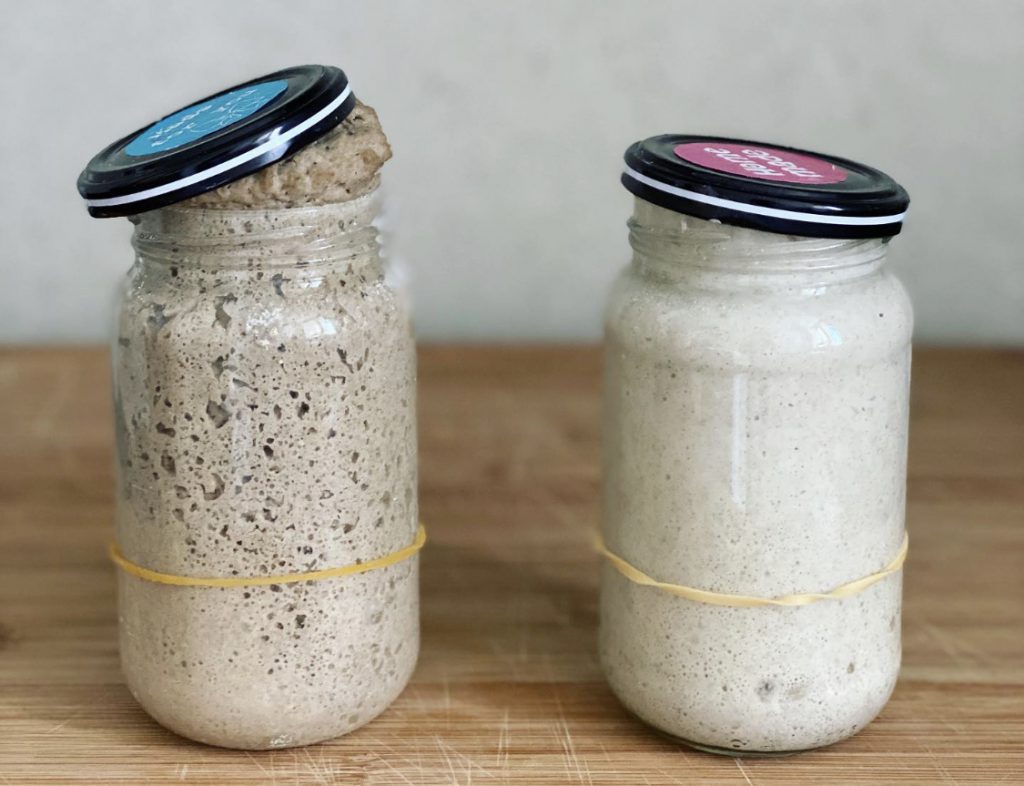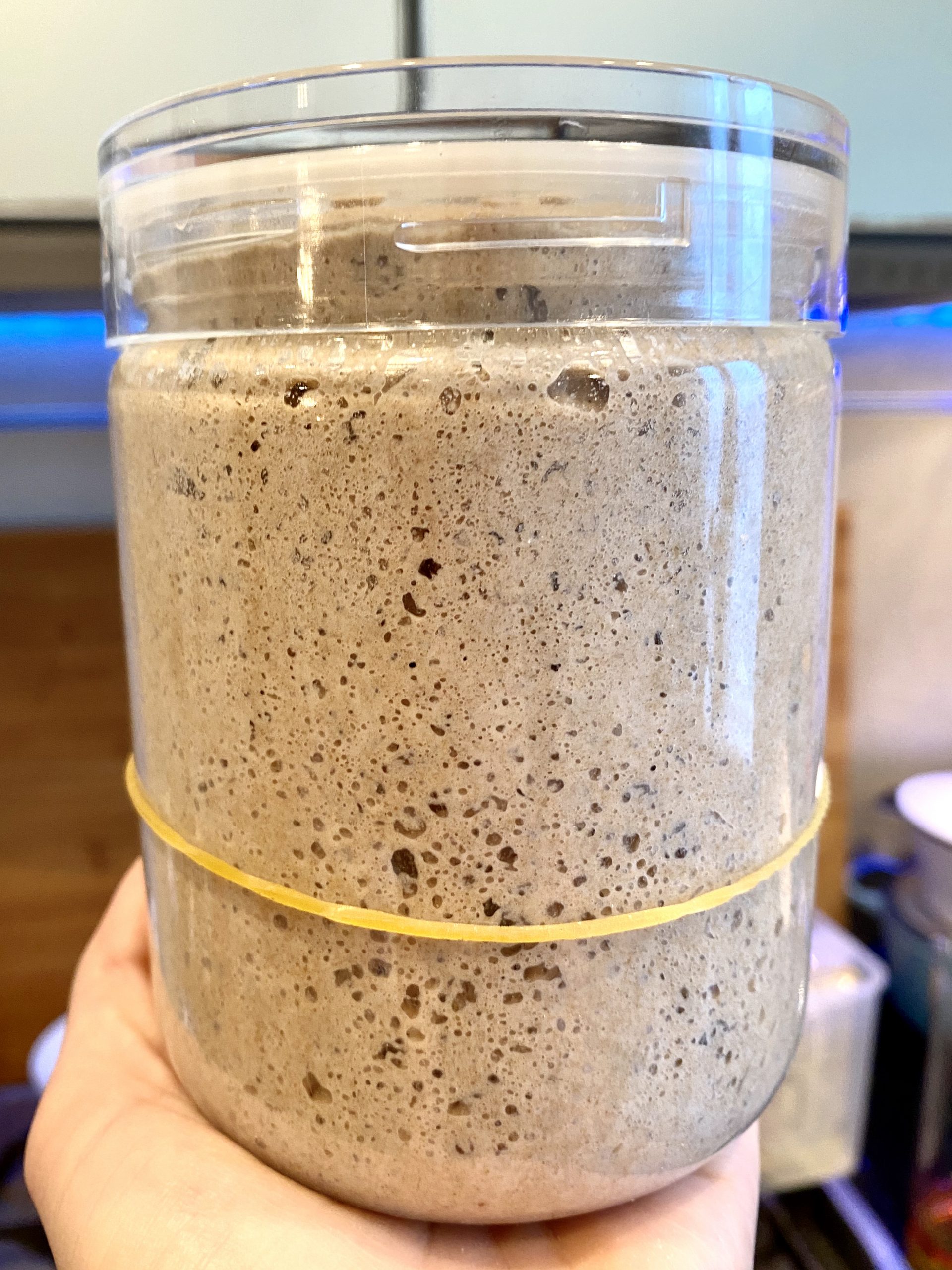Die unkomplizierteste Anleitung zur Starterpflege
Du hast einen richtig starken Sauerteig-Starter angesetzt. Hier erfährst du, was er braucht, um lebendig und glücklich zu bleiben – und das ist weniger Arbeit, als du vielleicht denkst!
Regelmäßige Fütterungen
Dein Starter besteht aus Mikroorganismen, vor allem Milchsäurebakterien und wilden Hefen. Sie brauchen regelmäßig frisches Mehl und Wasser, um am Leben zu bleiben.
„Regelmäßig“ heißt aber nicht, dass du deinen Starter ständig füttern musst, nur um ab und zu zu backen. Du kannst deine Fütterungsroutine an dein Backverhalten anpassen.
Wenn du nicht täglich bäckst, kannst du deinen Starter im Kühlschrank aufbewahren. Dort hält er es locker ein bis zwei Wochen ohne Fütterung aus. Wenn du ihn brauchst, holst du ihn raus, fütterst ihn und gibst ihm etwas Zeit, um wieder aktiv zu werden. Manchmal braucht er zwei Fütterungen, um wieder richtig in Schwung zu kommen – je nachdem, wie stark er vorher war und wie lange er im Kühlschrank stand.
Wenn du öfter bäckst, kannst du deinen Starter bei Zimmertemperatur aufbewahren. Die Gärung läuft dann schneller ab, das heißt: Du musst auch öfter füttern, damit er gesund bleibt. Zwei Fütterungen am Tag sind ein guter Richtwert. Dabei entsteht allerdings viel Starter – also musst du entweder sehr oft backen oder regelmäßig etwas davon wegwerfen.
Die richtige Futtermenge
Ein Sauerteig-Starter ist ziemlich robust (lass dir nichts anderes einreden). Du musst keine Wissenschaft daraus machen, ihn zu füttern.
Aber: Wenn du ihn dauerhaft über- oder unterfütterst, wird er schwächer – und dein Teig geht nicht mehr so gut auf. Zum Glück kannst du auf die Erfahrungen anderer Bäcker*innen zurückgreifen und bewährte Fütterungsverhältnisse nutzen, um ein gutes Gleichgewicht zu finden.
Der Goldstandard: Das Fütterungsverhältnis 1:2:2
Die 1 steht für das sogenannte „Anstellgut“ – also die Menge Starter, die du füttern willst. Die beiden 2er stehen für die Menge Wasser und Mehl, die du dazugibst – jeweils doppelt so viel wie vom Anstellgut.
Ein Beispiel: Du hast 30 g Starter und möchtest ihn im Verhältnis 1:2:2 füttern. Du gibst 60 g Wasser und 60 g Mehl hinzu.
1 = 30g Anstellgut
2 = 60g Wasser
2 = 60g Mehl
Diese Verhältnisse sind ein guter Ausgangspunkt, aber du musst sie nicht sklavisch einhalten. Wenn dein Starter schneller einsatzbereit sein soll, kannst du einfach mehr Anstellgut verwenden. Oder du nimmst weniger, wenn du ihn abends fütterst und morgens backen möchtest. Du wirst trotzdem tolles Brot backen – versprochen.




Hi, is it true that we must avoid metal spoon to stir it ?
THanks
Dear Mikk, I’ve heard that, too. However, I’ve used a metal spoon to stir my starter for several months and I didn’t have any problems. I switched to silicone spatulas because they’re a little bit more convenient to use.
I’ve had my starter for 8 years. I make a slurry with the water and starter, then add my flour and it’s all done with a bread whisk, which is metal. I wouldn’t store it in metal or plastic, though. I think the fermenting could eat at the plastic. I typically use mason jars with plastic wrap between the lid and screw band on the countertop and a crock in the fridge.
Good points, Regina!
To all fellow bakers: please, please, please do not discard! I have been baking sourdough bread 2 times a week for a year and have not thrown out any precious organic flour starter. After each baking, I just keep the remaining 2 tablespoons of starter in the jar in the fridge. The night before I need it for the next bread, I feed it and keep it in the fridge. In the morning I take it out and it rises much faster than it would if I just fed it in the morning. If I put the jar in a bowl of warm water, it doubles in 90 minutes to 2 hours.
Thank you for the advice on this site.
I agree. I rarely discard. It’s a pity to throw out starter regularly.
Happy baking, Marguerite!
My starter is about 7 or 8 years old. I was new to sourdough and a friend bought me a 100 year old starter from San Francisco. It arrived dehydrated. I began feeding it as per the directions and after a couple of weeks I noticed that it smelled the same as the one I started from scratch.
I struggle sometimes with the texture of my bread. I think it is often a cross between spongy and rubbery. I’m going to try your recipe, but is there something I’m doing wrong?
Hi Regina, a 100 year old starter from San Francisco, that sounds great! Have you noticed a difference to how your starter behaves? As for your bread, what’s the recipe you’re using? With gummy/rubbery texture it could be an issue of fermentation timing.
My starter is at least 50years old. I gave all my family a jar, but none of them kept it up. my starter sits in my fridge “separated,” and i only stir it when im ready to use it, about once every couple years. I have lost the original directions i was given 25years ago. i need some direction on how much to use for a loaf of bread. Any help is encouraged here !
bruce in Litttleton, Co.
A 50 year old starter, that’s impressive! Of course, happy to help. If you look at the recipes I shared, like the rye sourdough or the least complicated white sourdough ever, you’ll find the amounts of starter / levain you’ll need. They vary depending on the recipe and the size of the loaf you’re making.